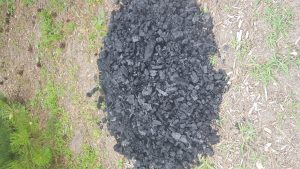Core to AlphaSource Advisors, is the mission to discover sustainable strategies that have a social and environmental impact. We invest in solutions that target climate change and enable local communities to thrive with a sustainable livelihood. Which is why we partnered with Wildlife Works, the world’s leading Reduced Emissions from Deforestation and Degradation (REDD+) project management and development company.
They launched the Kasigau Corridor REDD+ project, located in southeastern Kenya. It protects a total of 200,000 hectares (500,000 acres) of dryland forest and provides the rural community of 100,000 people with the benefits of carbon financing. Not only does this effort drive sustainable development in local communities, but it also protects the vital wildlife—an endangered population of African elephant, Grevy’s zebra, cheetah, lion and African wild dog. This flagship project advances the region’s progress in education, water access, agricultural intensification, health services, job creation, alternative sources of energy-production, and infrastructure.
The Kasigau Corridor REDD+ project is a market-based conservation solution which secures the entire wildlife migration corridor, bisecting the region of Tsavo—Kenya’s largest national park and home to half the country’s estimated 25,000 elephants. It is a pioneering program, the first REDD+ project to gain both the Verified Carbon Standard (VCS), and the Climate Community and Biodiversity Standard (CCB) to certify the accuracy for issuing credit for Voluntary Emission Reductions (VERs) in the carbon market. This flagship project achieved CCB Gold level certification for exceptional biodiversity and climate change adaptation benefits. They focus on establishing relationships within the local communities to drive impact: opportunities for sustainable development are launched, deforestation is reduced, and the valuable ecosystem is protected.
Here is a breakdown of the substantial results that have already been demonstrated in the Kasigau Corridor REDD+ project:
FORESTS – KEY TO THE SOLUTION
A holistic and robust forest community landscape is crucial for sustainable development. The triple bottom line investment strategy, with a focus on the people, planet and profit, can combat deforestation while providing investors with targeted returns. Studies show that without additional action, the intended nationally determined contributions (INDCs) are insufficient to limit warming to below 2°C and avoid some of the worst climate impacts. The Paris Agreement commitments to reduce emissions still leave a 12B-14B ton gap by 2030. In order to bridge this shortfall, a comprehensive initiative must be taken. It begins with the forest. The AlphaSource Climate Fund supports sustainable forest conservation development while establishing quantifiable impact metrics for investors. Our goal is to reduce at least 175 million tCO2e/yr, which would contribute to 17.5% of the global forest emission reduction target by 2020. With differentiated access to impact and returns, exposure to investment opportunities is dispersed within a vetted pipeline of sustainable forest conservation developers in a REDD+ marketplace and VERs (Verified Emission Reductions). The pipeline includes 20 countries that make up 77% of all historical forest emissions identified below. Assuming a mean carbon price of $6/tCO2e (avg. price achieved by Wildlife Works from 2012 – 2015), this would create revenues of $1B/yr. Sharing this revenue will generate a real financial alternative to destructive use of the forest, creating the basis for low carbon economies within forest communities, as well as within local and national governments. More than thirty million acres are deforested every year, causing 7B tons of GHG emissions. However, we can enable communities to protect these forests.
The preservation and reconstruction of this wildlife habitat through the AlphaSource Climate Fund provides a litany of benefits. While mitigating millions of tons of CO2 from seeping into the atmosphere, our initiative makes an investment within the local communities as well. It supports infrastructure improvements, healthcare, education and the conversion to renewable energy sources. Water access, purification and conservation are a central focus with reverberating effects such as the reduction in the risk of disease through improved waste management. The investment in climate-smart technologies will enhance efficiencies and reduce commodity pipeline carbon footprints, a pivotal step to enable a sustainable livelihood for these communities.
Forests are the cornerstone, which support the entire system. Therefore, it becomes an imperative to support these mechanisms that will continuously provide an incentive for conservation.
The uncorrelated, global and diversified returns ensure our exposure to impact investment opportunities that support experienced REDD+ developers which meet our criteria. Transformative REDD+ projects address local, regional and national Green Development goals that serve international climate mitigation objectives. The drivers of deforestation are critically targeted by investing in six dimensions of green development. These include:
Assuming a mean carbon price of $6/tCO2e (avg. price achieved by Wildlife Works from 2012 – 2015), this would create revenues of $1B/yr. Sharing this revenue will generate a real financial alternative to destructive use of the forest, creating the basis for low carbon economies within forest communities, as well as within local and national governments. More than thirty million acres are deforested every year, causing 7B tons of GHG emissions. However, we can enable communities to protect these forests.
The preservation and reconstruction of this wildlife habitat through the AlphaSource Climate Fund provides a litany of benefits. While mitigating millions of tons of CO2 from seeping into the atmosphere, our initiative makes an investment within the local communities as well. It supports infrastructure improvements, healthcare, education and the conversion to renewable energy sources. Water access, purification and conservation are a central focus with reverberating effects such as the reduction in the risk of disease through improved waste management. The investment in climate-smart technologies will enhance efficiencies and reduce commodity pipeline carbon footprints, a pivotal step to enable a sustainable livelihood for these communities.
Forests are the cornerstone, which support the entire system. Therefore, it becomes an imperative to support these mechanisms that will continuously provide an incentive for conservation.
The uncorrelated, global and diversified returns ensure our exposure to impact investment opportunities that support experienced REDD+ developers which meet our criteria. Transformative REDD+ projects address local, regional and national Green Development goals that serve international climate mitigation objectives. The drivers of deforestation are critically targeted by investing in six dimensions of green development. These include:
- Food
- Education
- Health
- Job Creation
- Energy
- Infrastructure or Housing
 Another crucial method of slowing global warming is sequestering CO2 from fast-growing biomass into a finished product called biochar. This 2,000 year-old practice converts basic material such as manure, compost or agricultural/organic waste into a highly porous charcoal that helps soil to retain nutrients and water. A simple, yet powerful tool which has the potential to remove up to eight gigatons of carbon dioxide equivalent from the atmosphere every year.
While the world is barreling toward the limit warming of 2°C, in order to get on track, pivotal resources such as the forest must be conserved and reconstructed. By enabling local communities to sustain themselves without resorting to environmentally-devastating tactics of deforestation, we can create an incentive for perpetual growth. This will provide investors with a scalable strategy with differentiated access to impact and uncorrelated, diversified returns. Combating deforestation is the main pillar of the AlphaSource Climate Fund. On a global scale, the key to moving forward, toward a more sustainable future, lies within the forests.
Another crucial method of slowing global warming is sequestering CO2 from fast-growing biomass into a finished product called biochar. This 2,000 year-old practice converts basic material such as manure, compost or agricultural/organic waste into a highly porous charcoal that helps soil to retain nutrients and water. A simple, yet powerful tool which has the potential to remove up to eight gigatons of carbon dioxide equivalent from the atmosphere every year.
While the world is barreling toward the limit warming of 2°C, in order to get on track, pivotal resources such as the forest must be conserved and reconstructed. By enabling local communities to sustain themselves without resorting to environmentally-devastating tactics of deforestation, we can create an incentive for perpetual growth. This will provide investors with a scalable strategy with differentiated access to impact and uncorrelated, diversified returns. Combating deforestation is the main pillar of the AlphaSource Climate Fund. On a global scale, the key to moving forward, toward a more sustainable future, lies within the forests.



